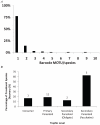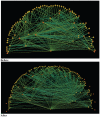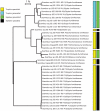Barcoding a quantified food web: crypsis, concepts, ecology and hypotheses
- PMID: 21754977
- PMCID: PMC3130735
- DOI: 10.1371/journal.pone.0014424
Barcoding a quantified food web: crypsis, concepts, ecology and hypotheses
Abstract
The efficient and effective monitoring of individuals and populations is critically dependent on correct species identification. While this point may seem obvious, identifying the majority of the more than 100 natural enemies involved in the spruce budworm (Choristoneura fumiferana--SBW) food web remains a non-trivial endeavor. Insect parasitoids play a major role in the processes governing the population dynamics of SBW throughout eastern North America. However, these species are at the leading edge of the taxonomic impediment and integrating standardized identification capacity into existing field programs would provide clear benefits. We asked to what extent DNA barcoding the SBW food web would alter our understanding of the diversity and connectence of the food web and the frequency of generalists vs. specialists in different forest habitats. We DNA barcoded over 10% of the insects collected from the SBW food web in three New Brunswick forest plots from 1983 to 1993. For 30% of these specimens, we amplified at least one additional nuclear region. When the nodes of the food web were estimated based on barcode divergences (using molecular operational taxonomic units (MOTU) or phylogenetic diversity (PD)--the food web became much more diverse and connectence was reduced. We tested one measure of food web structure (the "bird feeder effect") and found no difference compared to the morphologically based predictions. Many, but not all, of the presumably polyphagous parasitoids now appear to be morphologically-cryptic host-specialists. To our knowledge, this project is the first to barcode a food web in which interactions have already been well-documented and described in space, time and abundance. It is poised to be a system in which field-based methods permit the identification capacity required by forestry scientists. Food web barcoding provided an effective tool for the accurate identification of all species involved in the cascading effects of future budworm outbreaks. Integrating standardized barcodes within food webs may ultimately change the face of community ecology. This will be most poignantly felt in food webs that have not yet been quantified. Here, more accurate and precise connections will be within the grasp of any researcher for the first time.
Conflict of interest statement
Figures






Similar articles
-
Fluctuations in density of an outbreak species drive diversity cascades in food webs.Proc Natl Acad Sci U S A. 2007 Oct 23;104(43):16976-81. doi: 10.1073/pnas.0704301104. Epub 2007 Oct 15. Proc Natl Acad Sci U S A. 2007. PMID: 17940003 Free PMC article.
-
Spatial patterns of hyperparasitism along a latitudinal gradient of forest genus diversity: insights from the spruce budworm-parasitoids community.Environ Entomol. 2024 Feb 20;53(1):116-126. doi: 10.1093/ee/nvad110. Environ Entomol. 2024. PMID: 38006330
-
DNA barcoding for biodiversity assessment: Croatian stoneflies (Insecta: Plecoptera).PeerJ. 2022 Apr 20;10:e13213. doi: 10.7717/peerj.13213. eCollection 2022. PeerJ. 2022. PMID: 35469200 Free PMC article.
-
Paradigms in Eastern Spruce Budworm (Lepidoptera: Tortricidae) Population Ecology: A Century of Debate.Environ Entomol. 2016 Dec;45(6):1333-1342. doi: 10.1093/ee/nvw103. Epub 2016 Sep 1. Environ Entomol. 2016. PMID: 28028079 Review.
-
The use of DNA barcodes in food web construction-terrestrial and aquatic ecologists unite!Genome. 2016 Sep;59(9):603-28. doi: 10.1139/gen-2015-0229. Epub 2016 Apr 20. Genome. 2016. PMID: 27484156 Review.
Cited by
-
Host specificity of parasitoids (Encyrtidae) toward armored scale insects (Diaspididae): Untangling the effect of cryptic species on quantitative food webs.Ecol Evol. 2018 Jul 13;8(16):7879-7893. doi: 10.1002/ece3.4344. eCollection 2018 Aug. Ecol Evol. 2018. PMID: 30250670 Free PMC article.
-
Seeing is believing? Comparing plant-herbivore networks constructed by field co-occurrence and DNA barcoding methods for gaining insights into network structures.Ecol Evol. 2019 Feb 7;9(4):1764-1776. doi: 10.1002/ece3.4860. eCollection 2019 Feb. Ecol Evol. 2019. PMID: 30847071 Free PMC article.
-
Molecular detection of trophic interactions: emerging trends, distinct advantages, significant considerations and conservation applications.Evol Appl. 2014 Nov;7(9):1144-57. doi: 10.1111/eva.12225. Epub 2014 Oct 29. Evol Appl. 2014. PMID: 25553074 Free PMC article. Review.
-
Delineation of six species of the primitive algal genus Glaucocystis based on in situ ultrastructural characteristics.Sci Rep. 2016 Jul 7;6:29209. doi: 10.1038/srep29209. Sci Rep. 2016. PMID: 27383831 Free PMC article.
-
Incomplete lineage sorting and ancient admixture, and speciation without morphological change in ghost-worm cryptic species.PeerJ. 2021 Feb 9;9:e10896. doi: 10.7717/peerj.10896. eCollection 2021. PeerJ. 2021. PMID: 33614296 Free PMC article.
References
-
- Royama T. Population and Community Biology U.K Chapman & Hall; 1992. Analytical Population Dynamics.372
-
- Canada H. wwwpmra-arlagcca/english/pdf/spm/ipmsprucebudworm-epdf ISBN: 0-662-36361-2; 2005. Principles of Spruce Budworm Integrated Pest Management (IPM).
-
- Canada NR. State of Canada's Forests: Annual Report 2009. 2009. http://dsp-psdpwgscgcca/collection_2009/nrcan/Fo1-6-2009Epdf.
-
- MacLean DA, Erdle TA, MacKinnon WE, Porter KB, Beaton KP, et al. The Spruce Budworm Decision Support System: forest protection planning to sustain long-term wood supply. Canadian Journal of Forestry Research. 2001;31:1742–1757.
-
- Fernanez-Triana JL, Huber JT. The braconid parasitoids (Hymenoptera: Braconidae) of Nearctic Choristoneura species (Lepidoptera: Tortricidae), with a summary of other parasitoid families attacking Choristoneura. The Canadian Entomologist. 2010;142:1–49.
Publication types
MeSH terms
LinkOut - more resources
Full Text Sources

